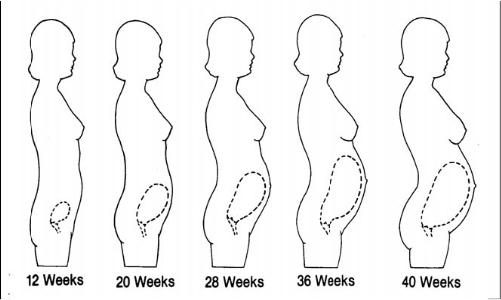This is the Archived Desktop Edition.
You should be transferred to the Newest Edition for Desktop and Mobile within 2 seconds.
|
Lesson 5: Physiologic Changes During Pregnancy
5-6. CHANGES OF THE RESPIRATORY SYSTEM DURING PREGNANCY
a. The respiratory rate rises to 18 to 20 to compensate for increased maternal oxygen consumption, which is needed for demands of the uterus, the placenta, and the fetus.
b. Women may feel out of breath and may need to sit a moment to catch their breath.
5-7. CHANGES OF BODY TEMPERATURE DURING PREGNANCY
a. A slight increase in body temperature in early pregnancy is noted. The temperature returns to normal at about the 16th week of gestation.
b. The patient may feel warmer or experience "hot flashes" caused by increased hormonal level and basal metabolic rate.
5-8. CHANGES OF THE URINARY SYSTEM DURING PREGNANCY
a. The kidneys must work extra hard excreting the mother's own waste products plus those of the fetus. There is an increase in urinary output and a decrease in the specific gravity.
b. The patient may develop urine stasis and pyelonephritis in the right kidney. This is due to pressure on the right ureter resulting from displacement of the uterus slightly to the right by the sigmoid colon.
c. Frequent urination is a complaint during the first through third trimester. As the uterus rises out of the pelvic cavity in early pregnancy, pressure on the bladder decreases and frequency diminishes. When lightening occurs during the final weeks of pregnancy, pressure on the bladder returns to cause frequency.
5-9. CHANGES OF THE SKELETAL SYSTEM DURING PREGNANCY
a. There is a realignment of the spinal curvatures during pregnancy to maintain balance (see figure 5-3). It is due to the increase in size of the uterus and pressure on the abdominal wall. The patient walks with head and shoulders thrust backward and chest protruding outward to compensate. This gives the patient a "waddling" gait.
b. There is a slight relaxation and increased mobility of the pelvic joints, which allows stretching at the time of delivery of the infant.

Figure 5-3. Postural changes during pregnancy.
5-10. CHANGES OF THE GASTROINTESTINAL SYSTEM DURING PREGNANCY
a. As mentioned in paragraph 5-1, as the pregnancy progresses, the uterus enlarges. It rises up and out of the pelvic cavity. This action displaces the stomach, intestines, and other adjacent organs.
b. Peristalsis is slowed because of the production of the hormone progesterone, which decreases tone and mobility of smooth muscles. This slowing enhances the absorption of nutrients and slows the rate of secretion of hydrochloric acid and pepsin. Flare-up of peptic ulcers is uncommon in pregnancy. Slow emptying may increase nausea and heartburn (pyrosis). Relaxation of the cardiac sphincter may increase regurgitation and chance for heartburn. Movement through the large intestines is also slowed due to an increase in water consumption from this area. This increases the chance for constipation.
c. Nursing implications.
(1) If the mother has difficulty with nausea and/or heartburn, advise her to eat small, frequent meals.
(2) The patient should eat a well- balanced diet high in protein, iron, and calcium for fetal growth; high fiber and fluids to prevent constipation.
(3) The mother should not lie flat for 1 to 2 hours after eating because this may cause heartburn and/or regurgitation.
5-11. CHANGES OF SELECTED GLANDS OF THE ENDOCRINE SYSTEM DURING PREGNANCY
a.
Parathyroid Gland. This gland increases in size slightly. It meets the increased requirements for calcium needed for fetal growth.b.
Posterior Pituitary. Near the end of term, the posterior pituitary will begin to secrete oxytocin that was produced in the hypothalamus and stored there. It will serve to initiate labor.c.
Anterior Pituitary. At birth, the anterior pituitary will begin to secrete prolactin. This stimulates the production of breast milk.d.
Placenta. The placenta acts as a temporary endocrine gland during pregnancy. It produces large amounts of estrogen and progesterone by 10 to 12 weeks of pregnancy. It serves to maintain the growth of the uterus, helps to control uterine activity, and is responsible for many of the maternal changes in the body.5-12. CHANGES IN BODY WEIGHT DURING PREGNANCY
a. Normal weight gain is about 24 to 30 pounds during pregnancy.
b. Weight gain in pregnancy.
(1) There is a slight loss of pounds during early pregnancy if the patient experiences much nausea and vomiting.
(2) She then gains 2 to 4 pounds by the end of the first trimester.
(3) A gain of a pound per week is expected during the second and third trimesters.
(4) Monitoring of weight gain should be done in conjunction with close monitoring of blood pressure.
(5) A lack of significant weight gain may be an indication of intrauterine growth retardation (IUGR) of the infant.
(6) Patients with multiple fetuses will require a higher caloric diet and expect a higher weight gain than a patient with only one fetus.
c. Adequate protein intake should be emphasized to the patient for development of the healthy fetus and proper diet reviewed at each prenatal visit.
|
The Brookside Associates Medical Education Division is dedicated to the development and dissemination of medical information that may be useful to medical professionals and those in training to become medical professionals. This website is privately-held and not connected to any governmental agency. The views expressed here are those of the authors, and unless otherwise noted, do not necessarily reflect the views of the Brookside Associates, Ltd., any governmental or private organizations. All writings, discussions, and publications on this website are unclassified.
© 2007 Medical Education Division, Brookside Associates, Ltd. All rights reserved